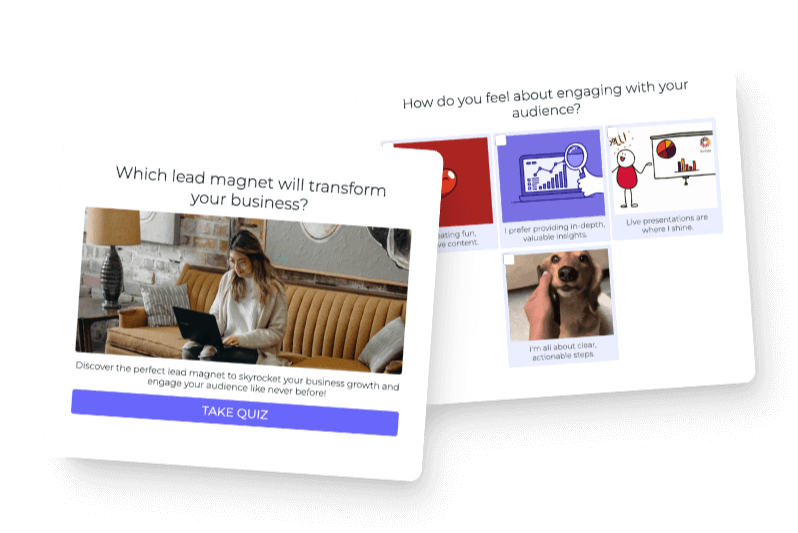Decision architecture, popularized by Nobel Prize Winner Richard Thaler, is the art of influencing people towards better decisions without taking away their autonomy. It’s like the friend who reminds you who you really are and encourages you to make the right choice that aligns with your values and convictions.
Quizzes are a very effective medium to deploy decision architecture because you can ask people who they are. By asking people about themselves, you can then turn that around and tell them “hey, you said you believe in this, so here’s what that means in regards to the topic of this quiz.”
At the end of the day, people make decisions in line with what they already think about the world. They rarely, if ever, change their opinions because of new data or information. Decision architecture is simply arranging that information the person already believes about the world in such a way as to insert an idea or action that aligns with what they think and suggest it as something that helps them with what they already want for themselves.
I want to walk through a quiz created by author Rebekah Lyons to demonstrate how decision architecture helps nudge people towards better decisions for themselves based on the information a quiz taker inputs while taking Rebekah’s quiz.
Step 1: Establish Common Ground.
Like any relational motivation, you first need to establish common ground with the person whom you would like to influence. In this case, the quiz asks the question “Where are you most resilient?” which uses positive psychology to establish a base of confidence between the quiz creator and quiz taker. It also reaffirms existing beliefs the quiz taker has about themselves, seeing themselves as resilient people.

Meeting people where they are is important because you don’t want to take them out of their window of tolerance. The window of tolerance is basically what people have capacity to handle in whatever mind-state they are in when they come across your quiz. Which is not much typically. People are busy, they have other priorities going on. So you need to join them in the place where they are, so you can begin the process of architecting a good decision without overwhelming them.

What I’m saying is that you need to address something in the life of the quiz taker that feels attainable to them. You can’t go after some big, hulking problem, or overwhelming life thing. You have to address something specific, actionable, and attainable. Like a SMART goal.
Step 2: Understand the person taking your quiz
Once you’ve established common ground around what you’re going to assist the quiz taker with, you have to get to know them. No one wants to listen to advice from people we don’t even know. So you need to get to know the person, and you need to ask them questions that make sense in the context of the quiz. I did a breakdown on question asking using Apple and Tesla as examples in this blog post.

You’ll need to ask enough questions, this one has 20 but the average is 13, to be able to get a good picture of how the person answering the questions operates. You need to ask enough relevant questions where the person taking the quiz feels very seen and listened to by the end of it. Otherwise they’re not going to listen to what you have to say to them.

Step 3: Spotlight the quiz taker, then advise on loss avoidance
Once someone answers a bunch of personal and potentially vulnerable questions about themselves throughout your quiz, they’re waiting with bated breath for what you’re going to say about them. Don’t let them down, spotlight them, put them in the limelight, focus on everything good and right about what they told you through the quiz questions.
Of course you have to be realistic, no one wants to hear blabbing about some junk that’s not relevant. You have to anchor everything positive you say about the person in the reality of what they told you about themselves.

In this case Rebekah uses both video and text to share positive things about the quiz taker. The content is well organized and easily digestible. It reads like a friend would talk. It’s both encouraging and practical. And really sets you up as a knowledgable assistant.

At the end of the result Rebekah offers a way to continue building your resilience by buying her book. This is the best way to motivate someone. That’s because now that you feel like you have resilience, you don’t want to lose it. Losing something you already have is much more painful than gaining that thing in the first place.

This called The Cumulative Prospect Theory, developed by Daniel Kanneman, it says that it’s more painful to lose than it is positive to gain. We assign more negative value to our losses than we assign positive value to our gains.

In the context of a quiz, if you tell someone “here’s what I think is special about you” and then offer the person a way to double down on that special thing, it’s more powerful than telling them “here’s what’s wrong with you, and how to fix it.”
That’s precisely because you are able to tap into the loss aversion instinct of people, and essentially help them see that they can avoid loss by following your suggestions. Tying this all back to the decision architecture framework, you have now aligned yourself with the goals of your quiz taker, gotten to know them as people, and then helped them see a way they can continue excelling with your help.
You are influencing them towards a good thing, which is to retain and improve on their already great attributes. And in this way you are helping architect positive decisions in their life.
